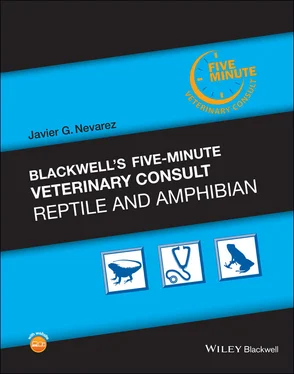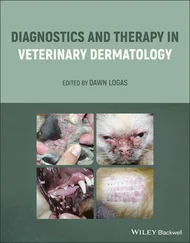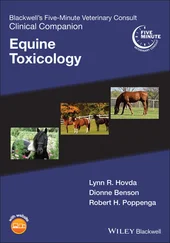Typically, signs are related to GI disorder and may include anorexia, weight loss, dehydration, diarrhea, and, in severe cases, death.
In cases of disseminated coccidiosis in chelonians, clinical signs may include pneumonia, inner ear infection, pancreatitis, and nephritis.
New (captive or wild) animals entering a collection with poor hygiene and high stocking densities.
Concurrent disease or excessive stress may cause immunosuppression, thus increasing the risks of disease expression.
 DIAGNOSIS
DIAGNOSIS
DIFFERENTIAL DIAGNOSIS
Other GI disease such as bacterial or protozoal infections (i.e., Isospora ).
Examination of feces for presence of oocysts using light microscopy is the most reliable test.
Molecular techniques such as PCR may aid in species delineation but are unlikely to improve treatment efficacy or prognosis.
Protozoa may also be seen in biopsy or necropsy samples.
For preservation of coccidia for future diagnostics, fecal samples should be stored in 2–3% of aqueous (w/v) K2Cr2O7.
Lesions may include proliferation of connective tissue and erosions of epithelial cells lining the intestines, gallbladder, and extra hepatic ducts.
There may also be an accompanying catarrhal or diphtheroid inflammatory response in the small and large intestines of affected animals.
 TREATMENT
TREATMENT
APPROPRIATE HEALTH CARE
N/A
Ensure that animals are well hydrated, especially if medicating with sulfa drugs.
In cases of anorectic animals, force‐feeding with easily digestible proteins should be initiated.
Some species can have direct feeding by stomach tubing, but placement of an esophagostomy tube should be considered for chronic management.
Supportive fluid therapy should be provided.
CLIENT EDUCATION/HUSBANDRY RECOMMENDATIONS
Remove and isolate sick individuals and reduce stress by providing optimal living conditions and hygiene.
Thoroughly clean the animal’s cage to reduce environmental contamination of oocysts.
Ensure that quarantine protocols have been adopted for all new arrivals; during quarantine, all animals should undergo repeated clinical and fecal examinations.
 MEDICATIONS
MEDICATIONS
DRUG(S) OF CHOICE
Because Eimeriaspp. are rarely pathogenic, prophylactic therapy or treatment should not be based on the identification of Eimeriaspp. alone, to avoid development of resistance.
Treatment should only be performed after an Eimeriasp. has been confirmed to be causing clinical disease.
Ponazuril 30 mg/kg PO q48h for 2 treatments, or 30 mg/kg PO q24h for 4 treatments, then repeat for 2–4 treatments 2 weeks apart.
Toltrazuril 15 mg/kg PO q48h for 30 days
Sulfadimethoxine 50 mg/kg q24h for 21 days
Trimethoprim‐sulfa 30 mg/kg daily for 5 days then q48h until the coccidia are eliminated.
Sulfa drugs are known to be nephrotoxic and care should be taken with their use, particularly in dehydrated or severely compromised individuals.
 FOLLOW‐UP
FOLLOW‐UP
PATIENT MONITORING
Repeat fecal examination at monthly intervals.
EXPECTED COURSE AND PROGNOSIS
Treatment may have variable efficacy as many protozoa are resistant to a range of anti‐coccidial medication.
Prognosis is good to guarded and is determined primarily by the state of the animal at initial presentation and the presence or absence of concurrent disease.
 MISCELLANEOUS
MISCELLANEOUS
COMMENTS
N/A
High host‐specificity. No known zoonotic risk with any Eimeria species.
N/A
GI = gastrointestinal
K2Cr2O7 = potassium dichromate
PCR = polymerase chain reaction
w/v = weight by volume
1 Gibbons PM. Advances in reptile clinical therapeutics. J Exot Pet Med 2014;23(1):21–38.
2 Helke KL, Cooper TK, Mankowski JL, Poynton SL. Disseminated visceral coccidi-
3 osis in Indo‐gangetic flap‐shelled turtles, Lissemys punctata andersonii. J Wildl Dis 2006;42(4):788–796.
4 Jacobson ER. Parasites and parasitic diseases of reptiles. In: Jacobson ER, ed. Infectious Diseases and Pathology of Reptiles: Color Atlas and Text. Boca Raton, FL: CRC Press; 2007:571–665.
5 Scullion FT, Scullion MG. Gastrointestinal protozoal diseases in reptiles. J Exot Pet Med 2009;18(4):266–278.
6 Vetterling JM, Widmer EA. Eimeria cascabeli sp. n. (Eimeriidae, Sporozoa) from rattlesnakes, with a review of the species of Eimeria from snakes. J Parasitol 1968;54(3):569–576.
AuthorT. Franciscus Scheelings, BVSc, MVSc, PhD, MANCVSc (Wildlife Health), DECZM (Herpetology)
Entamoeba
 BASICS
BASICS
DEFINITION/OVERVIEW
Entamoeba are characterized into two groupings based on morphology. The two groupings are based on the number of nuclei present. Entamoeba spp. in the group containing four nuclei are considered to be pathogenic and the main concern for reptilian species. Entamoeba spp. in the group containing eight nuclei are considered to be noninvasive. E. invadens is the most common pathogenic species seen in reptiles and has been known to cause significant mortality. Virulence can differ between strains of E. invadens ; infectious cysts are 11–20.2 μm with four nuclei and a small central karyosome. Trophozoites are 17.5–50 μm in length (average 36.18 μm), 10–25 μm (average 12 μm) in width and average diameter of 24.1 μm. Trophozoites also possess a single nuclei with a large central karysome that is 5–7.5 μm (average 5.65 μm) in diameter.
E. invadens has a direct life cycle and transmission is through the fecal–oral route.
Cysts are ingested and then undergo excystation in the intestinal tract.
In chelonians, cyst production occurs by cell division and one metacystic form gives rise to eight amoebas.
E. invadens mainly inhabits the small and large intestines but can affect other adjacent organs, including the liver, kidneys, pancreas, and lungs via systemic circulation.
Читать дальше

 DIAGNOSIS
DIAGNOSIS TREATMENT
TREATMENT MEDICATIONS
MEDICATIONS FOLLOW‐UP
FOLLOW‐UP MISCELLANEOUS
MISCELLANEOUS BASICS
BASICS










